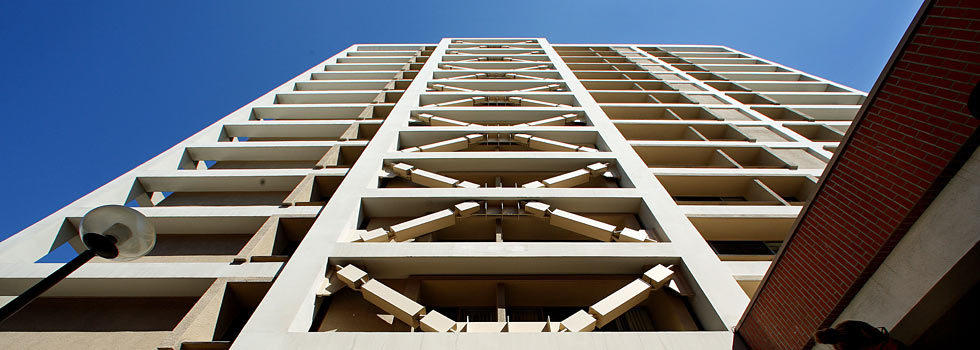FAQ Concrete buildings, earthquake safety and you

Webb Tower on the USC campus in Los Angeles had x-beams added from top to bottom to reinforce the structure in case of an earthquake. (Mel Melcon / Los Angeles Times)
Story: Many older L.A. buildings could collapse in an earthquake | Full coverage: California earthquake safety | Interactive map: L.A.’s hidden dangers
Structural engineers use steel reinforcing bars known as rebar to make the columns stronger and more flexible. The rebar forms a cage inside the concrete, allowing it to crack and bend without crumbling. After the 1971 Sylmar earthquake, building codes required new concrete structures to have more of these steel supports. The code did not address existing buildings. Experts said the only way to know whether a concrete building is at risk is to have an engineer inspect it.
No one knows because the vast majority of older concrete buildings have not been inspected by structural engineers to determine their seismic safety. After an exhaustive examination of public records, The Times estimates that about 1,200 buildings in the city of Los Angeles appear to be concrete and built before 1976, when the new codes went into effect. The Times estimates that there are 600 such buildings in the rest of Los Angeles County. University researchers did their own analysis and placed the number at 1,500 in the city of Los Angeles alone. A group of engineers and policymakers known as the Concrete Coalition estimates that there are as many as 17,000 non-ductile concrete buildings in California.
No. Multistory buildings pose the greatest danger because so many people live and work in them. But a single-story concrete building can collapse and cause deaths too, according to the Concrete Coalition. The Times’ survey reviewed only buildings four stories or taller and those with high occupancy. Experts say shorter buildings should be included in any formal inventory.
Northridge was a moderate, magnitude 6.7 earthquake centered more than 10 miles away from Hollywood, downtown and other large concentrations of concrete buildings in Los Angeles. Concrete buildings near the epicenter collapsed and would have killed hundreds had the earthquake not struck at 4:31 a.m., when the buildings were empty. Seismic experts say a larger earthquake closer to the city center would cause much more damage to concrete buildings.
A few have been retrofitted, but the vast majority have not. The city requires seismic upgrades when older office buildings and warehouses are converted into housing. The city provides guidelines for owners who want to voluntarily retrofit their buildings.
Retrofitted buildings do not have to meet the same standards as new ones. Both are designed to prevent deaths during an earthquake equivalent to magnitude 8 on the San Andreas fault. The standard for retrofitting older buildings requires them to be strong enough to remain standing so occupants can safely evacuate. But those buildings may be damaged beyond repair. Today’s code for new buildings requires them to withstand the earthquake with moderate damage that could be repaired. Some buildings such as hospitals have a higher standard, to remain operational after the quake.
Seismologists, structural engineers and academic researchers have been studying the hazards of concrete buildings since the 1971 Sylmar earthquake. The Times has collected the most significant reports from their body of work. Explore the research.
Credits: Doug Smith, Rong-Gong Lin II and Rosanna Xia